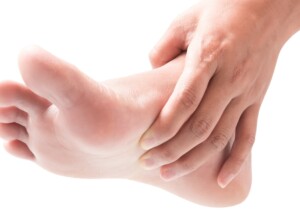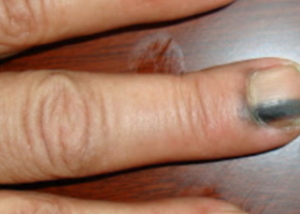
Though black adults are more likely to get nail melanoma, white and olive skinned children CAN get nail melanoma — which is deadly if not caught in time.
The actual nail itself isn’t cancerous; it’s the tissue beneath the nail. And through the nail, the growing tumor is visible.
It’s also more common in Native Americans and Asians than in whites.
Subungual melanoma in the pediatric population is rarely reported in medical literature due to its rarity.
And nearly all of the reported cases have been in dark skinned patients or Asians, says a paper in Pediatric Dermatology (Tosti et al, May 2011).
Tosti et al report two cases of nail melanoma in Caucasian children of Italian heritage.
Initially, the dark band in the young patients’ fingernails was diagnosed as the benign longitudinal melanonychia (LM) – because:
• Subungual melanoma can visibly mimic LM – even when viewed under a dermatoscope.
• Pediatricians will have a very low index of suspicion for melanoma in children since it’s so rare – especially of the nail unit.
• What increases the low index of suspicion is if the child is white or even olive.
In the case of these two patients, a biopsy confirmed melanoma in situ (the earliest stage of the disease).
What’s vexing to clinicians is that the features of subungual melanoma in adults are often present in benign pigmented lesions of children.
The paper concludes that there is a need to establish parameters useful for physicians and pathologists in the correct diagnosis of dark bands in children’s fingernails.
You’ve Noticed a Dark Line in Your White Child’s Fingernail

Freepik.com
“A dark streak on the nail is known as longitudinal melanonychia in medical terms,” says Adam J. Mamelak, MD, a board certified dermatologist and founder of Sanova Dermatology in Austin, TX.
“It most often represents a mole or growth in the nail bed — the skin on the finger or toe from which the nails grow.
“If a mole develops in the nail bed, some of the pigment can be pulled out and deposited in the growing nail plate, forming a dark streak in the nail.
“Acral moles, or moles affecting any part of the hands and feet, are more common in African Americans and Asians. However, really, anyone could get one.”
Iorizzo et al, in the journal Dermatologic Surgery (July 2008) states: “To our knowledge, until now only eight cases have been reported in the literature.” This refers to nail melanoma in children.
If your child (dark or light skinned) has a vertical dark line, stripe or band in a fingernail, this is likely a benign LM or the result of recent trauma (harmless dried blood).
Both can mimic the appearance of nail unit melanoma. However, the likelihood that what you’re seeing actually is cancer is incredibly low, especially if your child is white or does not have dark skin.
What Parents Must Be on the Lookout for
“Most studies show the chance of a small mole (<1cm ) becoming cancerous is less than 1% in an individual less than 18 years old (it is even rarer before the teenage years),” says Dr. Mamelak.
“As long as the streak is not changing significantly in color or width, and the pigment stays confined to the nail (and does not grow onto the skin around the nail), it is likely okay just to monitor it.”
If more than two digits have identical pigmentation, this significantly lessens the odds that it’s melanoma, since the disease virtually never affects more than one digit.
If the diagnosis is LM, this does not mean forget about the dark stripe.
Prolonged follow-up is recommended, since on occasion, adults with nail apparatus melanoma have been found to have had a childhood history of longitudinal melanonychia.
“I will take photos and measurements of these nail streaks in the clinic and re-evaluate them two to three months later to make sure they are not changing significantly,” says Dr. Mamelak.
“If I do see a worrisome change, I recommend a nail biopsy for a definitive diagnosis.”
Though melanoma under a nail is extraordinarily rare in white – as well as black – children, this doesn’t mean lower your guard.
Simply be mindful, as you are regarding other potentially serious though extremely rare events that can harm your child – such as lightning strikes, snake bites and shark attacks.
Since it’s not impossible for Caucasian children to develop melanoma in a nail unit, it’s important to maintain regular surveillance per your child’s dermatologist’s guidelines.

 Dr. Mamelak
Dr. Mamelak







































